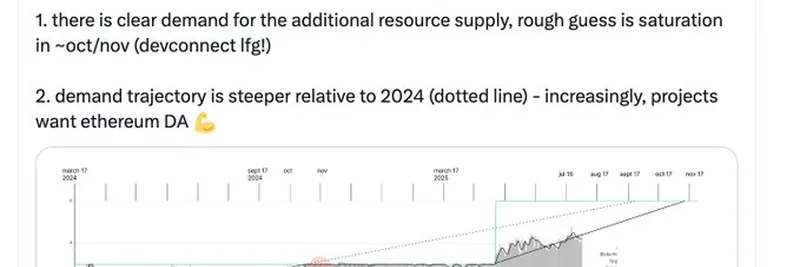Hey there, crypto enthusiasts! If you’ve been keeping an eye on the Ethereum blockchain lately, you’ve probably heard about the exciting upgrades shaping its future. A recent tweet from trent.eth dives into some juicy details about Ethereum’s scaling progress three months after the Pectra upgrade. Let’s break it down in a way that’s easy to digest, even if you’re new to the blockchain game.
What’s the Buzz About Blob TA Post-Pectra?
The tweet highlights two key points about Ethereum’s current state:
Growing Demand for Resources: There’s a clear need for more resource supply, with saturation expected around October or November (shoutout to Devconnect for the timing clue!). This means Ethereum’s network is getting busier, and it’s struggling to keep up with the demand for data storage and processing.
Steep Demand Trajectory: Compared to 2024 (shown as a dotted line), the demand for Ethereum’s Data Availability (DA) is climbing fast. Projects are increasingly relying on Ethereum’s infrastructure, and the tweet playfully suggests they’re “flexing” for more capacity with a muscle emoji!
Accompanying the tweet is a chart that paints a picture of this growth. It shows a steady increase in blob usage (a technical term for data chunks stored on Ethereum) since the Pectra upgrade in May 2025. The chart even projects a sharp rise, hinting that Ethereum’s network is gearing up for some serious scaling.
What’s Pectra, and Why Does It Matter?
The Pectra upgrade, rolled out in May 2025, was a big deal for Ethereum. Think of it like a software update for the blockchain that boosts its performance. One of the standout changes was increasing the amount of ETH you can stake from 32 to 2,048, making it easier for validators (the folks who secure the network) to operate. But that’s not all—Pectra also bumped up blob capacity by 50%, giving Ethereum more room to handle data from Layer 2 solutions (like rollups, which process transactions off the main chain to save space).
This upgrade is part of Ethereum’s strategy to scale without sacrificing security or uptime. The tweet’s data suggests this extra capacity is already being gobbled up, showing how hungry the ecosystem is for more.
Looking Ahead: Fusaka and Beyond
The tweet also teases future upgrades, like Fusaka, expected in Q4 2025. Fusaka will introduce Peer-to-Peer Data Availability Sampling (PeerDAS), a fancy way of saying Ethereum nodes will only download small chunks of data instead of everything. This could safely increase data capacity per block, making the network even more efficient. It’s all about keeping up with the growing demand from projects and users.
Why Should Meme Token Fans Care?
You might be wondering, “What does this have to do with meme tokens?” Well, a lot! Many meme tokens and decentralized apps (dApps) run on Ethereum or its Layer 2s. As Ethereum scales, it becomes a stronger foundation for these projects, potentially boosting their performance and adoption. Imagine faster transactions for your favorite meme coin swaps or more room for wild new token launches!
The Takeaway
Ethereum’s scaling journey is heating up, and the post-Pectra blob TA data is proof. With demand soaring and upgrades like Pectra and Fusaka on the horizon, the network is gearing up to handle more traffic while keeping things secure. Whether you’re a blockchain newbie or a seasoned pro, keeping an eye on these developments can help you stay ahead in the meme token and crypto space.
What do you think about Ethereum’s scaling plans? Drop your thoughts in the comments, and let’s chat about how this might shake up the meme token world! For more blockchain insights, check out meme-insider.com.


